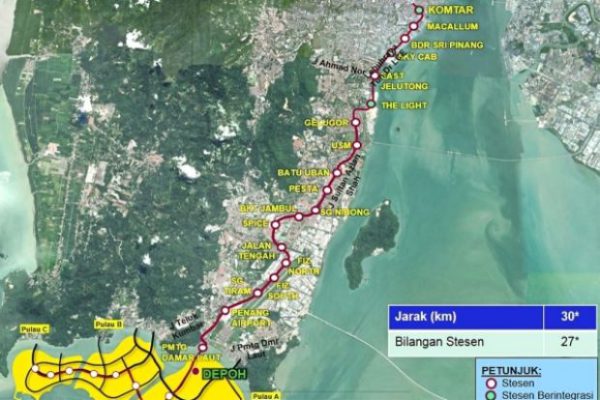Penang’s PIL and LRT to go ahead
Construction on the RM9bil light rail transit (LRT) line and the RM9.6bil Pan Island Link 1 (PIL 1) in Penang are scheduled to start in June next year. The PIL has received approval from the Department of Environment – the federal regulator overseeing the Environmental Impact Assessment (EIA) report – in March while the LRT is expected to receive a conditional approval from the Transport Ministry in May. Both mega projects will be tendered to local and international companies at the end of the year. According to sources, construction work for both projects are expected to start in June 2020. Both the LRT and PIL are components of the RM46bil Penang Transport Master Plan (PTMP). The LRT is an integrated transport solution comprising a monorail link, cable cars and water taxis to solve traffic congestion in Penang, while the 19.5km PIL highway project connects Gurney Drive to the Penang International Airport. (The Star Online)
Pavilion REIT to relook Bukit Jalil mall ownership
Pavilion REIT has opted not to participate in the ownership of the under-construction Pavilion Bukit Jalil mall to avoid unwanted risks, but believes the asset will be worth reconsidering upon its completion, said its manager. Pavilion REIT Management Sdn Bhd CEO Philip Ho hopes to receive an invitation from the owners again, post-construction. “If they do offer us [ownership], and if it is accretive, we will definitely review it. The mall will be completed between September 2020 and 2021, and we are quite confident that it will do well,” he said. The REIT considers assets with yields between 6.5% and 7% to be accretive. Earlier this year, Pavilion REIT announced that it would not buy a stake in the mall, but did not provide any reasons. (The Edge)
PR1MA project in Rantau to be completed in 2020
Housing and Local Government Minister Zuraida Kamaruddin said the unfinished 1Malaysia People’s Housing Scheme (PR1MA) project in Rantau, Negeri Sembilan will be completed by May 2020. The project, which should have been completed by Jan 31 this year, was discontinued after the appointed contractor of the affordable homes project ran into financial difficulties. “The ministry has identified a new contractor and they will start work at the construction site as soon as possible,” she said. There are a total of 766 homes under this project, including 210 single storey houses and 566 double story houses. The housing project, which is 56% complete, had been left abandoned since September last year. (NST Online)
ECRL to proceed at smaller scale, lower cost
Following months of negotiations, Malaysia and China have reached an agreement to resume the East Coast Rail Link (ECRL) project, which was suspended last July. It will be carried out on a smaller scale, and at a lower cost with some changes to the route, Sin Chew Daily reported. The cost of the project, which was originally tagged at RM66 billion, will be slashed by more than RM10 billion. A source said that the two parties had arrived at was a win-win solution as the re-negotiated project includes new commercial elements, which will bring about greater benefits to local entrepreneurs and people. According to the report, environmental considerations are the main reason that changes will be made to the ECRL route. (The Sun Daily)
EDTP a real estate game-changer for Johor
The Gemas-Johor Baru (JB) electrified double-track project (EDTP), a “game-changer” for the state’s economy, looks set to play a big role in the real estate development. Housing demand and price may rise in several areas in Johor with the launch of the rail service, which is expected by early 2022, according to real estate developers and consultants. The track runs from Gemas in Negri Sembilan to JB Sentral and covers 197km. It will have 11 intermediate KTM Southern Line stations: Segamat, Genuang, Labis, Bekok, Paloh, Kluang, Mengkibol, Rengam, Layang-Layang, Kulai and Kempas Baru. The railway line is expected to help spur demand for residential units in the region. Another economic benefit is that it will potentially help transform the surrounding areas into a commercial hub that will draw in businesses. Some areas along the LRT and MRT lines have seen property prices appreciate by 10-20%, but they are more or less stagnant now because of the current market situation. (NST Online)





